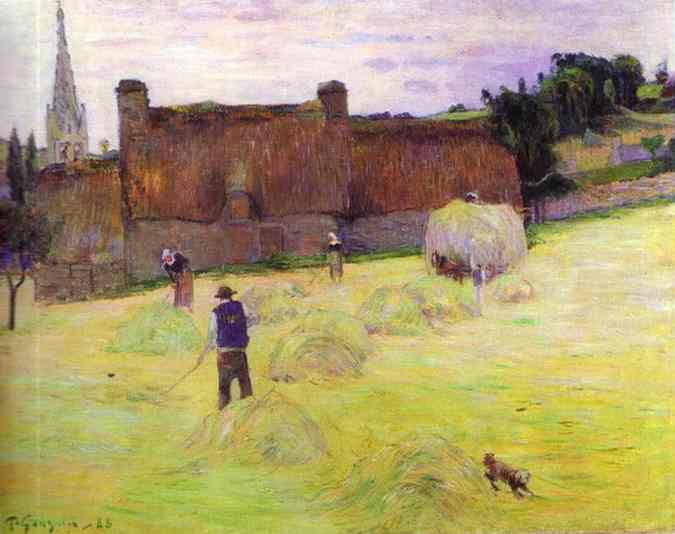Description
Paul Gauguin's Haymaking in Brittany (1888) is a fascinating depiction of rural life, encapsulating both the beauty of the Breton landscape and the everyday experience of its inhabitants. Set during a key period in Gauguin's artistic career, this painting is notable for its rich colour palette and composition that reflects the amalgamation of the real with the symbolic, characteristics that mark the beginning of his experimentation towards later generations of modern art.
The scene is set in a large field where women are working to harvest hay. The presence of female figures is another recurring element in Gauguin's work, who often explored the role of women in society. The workers are depicted with a sense of monumentality, almost iconic, which not only evokes the arduous agricultural work, but also brings together an innate grace in their composition. With traditional clothes and wide hats, the figures blend into the surroundings in an almost symbiotic way, reflecting both the work and the culture of the region.
The use of color in this painting is particularly significant. Gauguin applies vibrant and contrasting hues, lending a dynamic energy to the image. The field is bathed in a warm yellow that feels almost like a glow from the sun, infusing the work with a sense of vitality and luminosity. This predominant use of color is indicative of his transition into a more expressionist style, where color not only represents reality but also becomes a medium to convey emotion. Shadow and light intertwine in a precise manner, providing depth and perspective, while the blue hues in the background suggest a clear sky that blends into the horizon.
The composition of the work is balanced, guiding the eye through the figures and the landscape. The viewer's eye is drawn inexorably to the women engaged in their work, while the open space of the countryside amplifies the meaning of the scene. The simplicity of the action presented contrasts with the richness of the surroundings, offering a vision of rurality that goes beyond mere representation. This approach accompanies Gauguin's exploration of symbolism; his intention was not simply to portray what he saw, but also to imbue them with meaning.
"Haymaking in Brittany" reflects a moment when Gauguin was moving away from the strict norms of Impressionism towards a more personal and subjective style. His appreciation for rural life was not just a simple observation of everyday activity, but also a deep dialogue with the culture and spirit of the place he inhabited. We can see this in his choice of subjects and the way he shapes them, which resonates with a sense of respect and admiration towards the work of women and the Breton rural tradition.
This painting invites us to consider how the environment and those who inhabit it are intertwined in a dance of colour, light and form; an expression of the very essence of life in Brittany. Haymaking in Brittany is therefore not far from a visual manifesto that addresses not only the beauty of nature, but also progress and the living conditions of the time, thus questioning the place of the human being in this vast and glittering web of the world. The work positions itself within the rich tradition of landscape art and symbolism, articulating a future where colour and form speak to the human experience more deeply.
KUADROS ©, a famous painting on your wall.
Hand-made oil painting reproductions, with the quality of professional artists and the distinctive seal of KUADROS ©.
Painting reproduction service with satisfaction guarantee. If you are not completely satisfied with the replica of your painting, we will refund 100% of your money.

